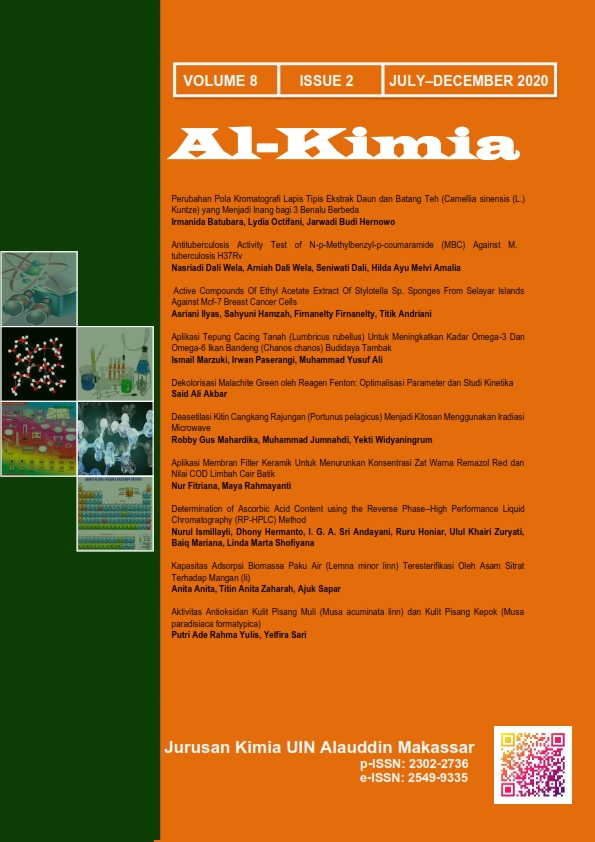Deasetilasi Kitin Cangkang Rajungan (Portunus pelagicus) Menjadi Kitosan Menggunakan Iradiasi Microwave
Abstract
The crab shell (Portunus pelagis) is still an untapped waste, especially on Bangka Island. Actually, this shell has a high value because there is chitin and chitosan. Chitosan is a biopolymer which has recently been developed into adsorbents, membranes and edible films. The deacetylation process of chitin will be the key to the quality of chitosan produced. Therefore, the purpose of this study is to see the effect of the chitin deacetylation process into chitosan using a microwave. Microwave deacetylation process is carried out with various time variations at 1200 W and 100oC. Characterization and degree of deacetylation (DD) of chitosan crab were analyzed by Fourier Transform Infrared (FTIR) spectroscopy. The results showed that deacetylation using conventional methods for 120 minutes at a temperature 100oC had DD 76.67% while deacetylation using microwave for 40 minutes at a temperature of 100oC had a DD 77.89%. Microwave deacetylation is three times faster than conventional methods.
Downloads
References
.Agustina, S., Swantara, M. D., & Suartha, I. N. (2015). Isolasi Kitin,Karakterisasi,dan Sintesis Kitosan dari Kulit Udang. Jurnal Kimia, 9, 271–278.
Alias, S. S., Ariff, Z. M., & Mohamad, A. A. (2015). Porous membrane based on chitosan-SiO2 for coin cell proton battery. Ceramics International, 41(4), 5484–5491.
https://doi.org/10.1016/j.ceramint.2014.12.119
Arifin, Z., & Irawan, D. (2015). Microwave-Assisted Deacetylation of Chitin from Shrimp Shells. Prosiding Seminar Nasional Teknik Kimia “Kejuangan,” (Dd), 1–5.
Bahri, S., Rahim, E. A., & Syarifuddin, S. (2018). DERAJAT DEASETILASI KITOSAN DARI CANGKANG KERANG DARAH DENGAN PENAMBAHAN NaOH SECARA BERTAHAP. Kovalen, 1(1), 36–42. https://doi.org/10.22487/j24775398.2015.v1.i1.5161
El Knidri, H., El Khalfaouy, R., Laajeb, A., Addaou, A., & Lahsini, A. (2016). Eco-friendly extraction and characterization of chitin and chitosan from the shrimp shell waste via microwave irradiation. Process Safety and Environmental Protection, 104, 395–405. https://doi.org/10.1016/j.psep.2016.09.020
Hargono, H., Abdullah, A., & Sumantri, I. (2017). Pembuatan Kitosan Dari Limbah Cangkang Udang Serta Aplikasinya Dalam Mereduksi Kolesterol Lemak Kambing. Reaktor, 12(1), 53. https://doi.org/10.14710/reaktor.12.1.53-57
Hemwimon, S., Pavasant, P., & Shotipruk, A. (2007). Microwave-assisted extraction of antioxidative anthraquinones from roots of Morinda citrifolia. Separation and Purification Technology, 54(1), 44–50. https://doi.org/10.1016/j.seppur.2006.08.014
Khan, T. A., Peh, K. K., & Ch’ng, H. S. (2002). Reporting degree of deacetylation values of chitosan: The influence of analytical methods. Journal of Pharmacy and Pharmaceutical Sciences, 5(3), 205–212.
Kiefer, J., Strk, A., Kiefer, A. L., & Glade, H. (2018). Infrared spectroscopic analysis of the inorganic deposits from water in domestic and technical heat exchangers. Energies, 11(4). https://doi.org/10.3390/en11040798
Kurniasih, M., & Kartika, D. (2011). Sintesis dan karakterisasi fisika-kimia kitosan. Jurnal Inovasi, 5(1), 42–48.
Sagheer, F. A. A., Al-Sughayer, M. A., Muslim, S., & Elsabee, M. Z. (2009). Extraction and characterization of chitin and chitosan from marine sources in Arabian Gulf. Carbohydrate Polymers, 77(2), 410–419. https://doi.org/10.1016/j.carbpol.2009.01.032
Setiani, W., Sudiarti, T., & Rahmidar, L. (2018). Preparasi Dan Karakterisasi Edible Film Dari Poliblend Pati Sukun-Kitosan. Jurnal Kimia VALENSI, 3(2). https://doi.org/10.15408/jkv.v3i2.506
Setyaningsih, W., Saputro, I. E., Palma, M., & Barroso, C. G. (2015). Optimisation and validation of the microwave-assisted extraction of phenolic compounds from rice grains. Food Chemistry, 169, 141–149. https://doi.org/10.1016/j.foodchem.2014.07.128
Tanasale, M., Killay, A., & Laratmase, M. (2012). Kitosan dari Limbah Kulit Kepiting Rajungan (Portunus sanginolentus L.) sebagai Adsorben Zat Warna Biru Metilena. Jurnal Natur Indonesia, 14(2), 165–171. Retrieved from http://ejournal.unri.ac.id/index.php/JN/article/view/216
Yasmeen, S., Kabiraz, M., Saha, B., Qadir, M., Gafur, M., & Masum, S. (2016). Chromium (VI) Ions Removal from Tannery Effluent using Chitosan-Microcrystalline Cellulose Composite as Adsorbent. International Research Journal of Pure and Applied Chemistry, 10(4), 1–14. https://doi.org/10.9734/IRJPAC/2016/23315
Copyright (c) 2020 Robby Gus Mahardika, Muhammad Jumnahdi, Yekti Widyaningrum

This work is licensed under a Creative Commons Attribution-NonCommercial-ShareAlike 4.0 International License.
Authors who publish with this journal agree to the following terms:
1) Authors retain copyright and grant the journal right of first publication with the work simultaneously licensed under a Creative Commons Attribution License that allows others to share the work with an acknowledgement of the work's authorship and initial publication in this journal.
2) Authors are able to enter into separate, additional contractual arrangements for the non-exclusive distribution of the journal's published version of the work (e.g., post it to an institutional repository or publish it in a book), with an acknowledgement of its initial publication in this journal.
3)Authors are permitted and encouraged to post their work online (e.g., in institutional repositories or on their website) prior to and during the submission process, as it can lead to productive exchanges, as well as earlier and greater citation of published work (See The Effect of Open Access).


